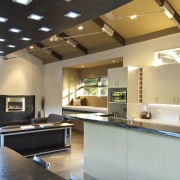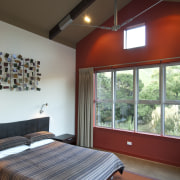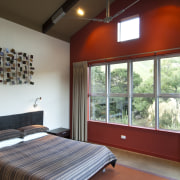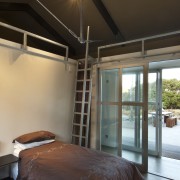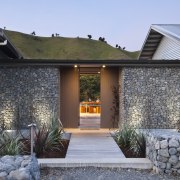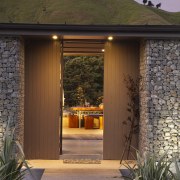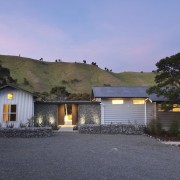Gone bush
With its corrugated steel, gabion stone walls and shed-like pavilions, this holiday retreat references its rural surroundings both outside and in

With so much of the rural Wairarapa landscape in New Zealand given over to farming and vineyards, a property that is almost entirely untouched native bush offers something quite special.
For architect Michael McKay, finding such a piece of land provided an ideal opportunity to explore the architectural vernacular while designing his own family retreat on a 5ha block.
McKay says he was particularly inspired by the corrugated iron woolsheds and farm buildings in the region.
"I love the shapes and materials of these buildings, and wanted to play with that architectural vocabulary. It was important that the house looked like it belonged on that road. I was also intrigued by the gabion stone walls that appear throughout the region the rock retaining walls that are held together by heavy wire mesh."
McKay says the architecture was also influenced by the orientation of the site and the need to maximise the sunlight while providing some protection from the prevailing easterly winds.
The end result of all these influences is a single-storey gabled house that comprises two linked, shed-like pavilions, positioned at right angles to each other. Both pavilions are clad in corrugated steel laid horizontally on the living pavilion and vertically on the exterior of the bedroom wing.
"This is exactly how the steel appears on local farm buildings," says McKay. "Sometimes it is vertical, sometimes horizontal. The horizontal lines of the living pavilion are repeated in the windows.In contrast, the windows in the bedroom wing have a strong verticality."
The flat-roofed entry, which links the two sides of the house, features gabion stone walls made from local river rock. Heavy-gauge stainless steel wire mesh contains the rocks, which have no mortar.

"The stone is a veneer, rather than a structural feature," says McKay. "Behind this wall is another fibre-cement wall."
Similar gabion stone walls are part of the landscaping at the front of the house.
With its solid wood entry doors and high walls, the house effectively turns its back to the road, but opens up to the sun and the bush and hill views to the rear.
"The opaque facade of the timber doors gives way to a wall of glass and triple-stacked sliding doors that lead to the outdoor entertaining area," says McKay.
A sense of space also defines the large family living room to the right of the entry. This room has an innovative trussed roof featuring radiata pine beams and a galvanised steel cable and turnbuckle system.
"I wanted to create something a little different," says the architect. "The exposed trusses are reminiscent of the interiors of shearing sheds. The high ceiling and the cross ventilation also help to cool the house during the long, hot summers."
McKay provided deep eaves on the north side of the house that keep out the sun in summer, but let it in during winter. At this time of the year, the concrete floor also acts as a thermal mass, releasing the sun's heat in the evening.
Other key features of the interior include built-in bench seats. A large window seat or day bed in the living room can double as an extra bed if required.

Local macrocarpa wood was used to create the kitchen bar top and the slabs for the dining table and matching overhead lighting fixture. The offcuts were turned into small tables and a fire surround.
"This is another motif in the house," says McKay. "Each of the slabs has three square edges and one natural edge. We also left the original saw marks to give it a rustic, rather than a polished patina."
The architect says the macrocarpa bar top is positioned at a height that makes it ideal for entertaining.
"Guests will lean on the bar and chat with the owners without intruding on the kitchen space."
The country charm extends outdoors, to what McKay calls the piéce de resistance a refurbished Victorian bathtub with solar powered water heating.
"The tub is large enough for two, and has proved to be the big surprise of the project. Lying there listening to the bird life is an idyllic way to unwind."
Credit list
Interior designer
Landscape design and installation
Roofing
Paints and varnishes
Heating
Benchtops
Oven, cooktop, ventilation and dishwasher
Curtains
Builder
Cladding
Roof trusses and structural steel
Flooring
Lighting
Doors and windows
Cabinetry
Kitchen mixer
Bathtub
Story by: Trendsideas
Home kitchen bathroom commercial design


